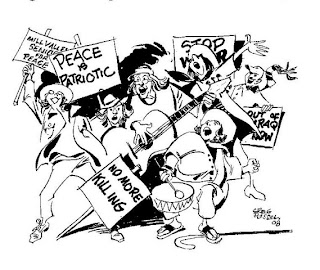February 2nd was the birthday of Creig Flessel. He would have been 100 !
I was very pleased to learn that The Art League of Long Island ( Dix Hills, New York) just held a month long exhibit of Creig’s work. (See: http://artleagueli.org/node/501 )
 |
| One of Creig's early comic book covers |
Creig was a grand master cartoonist and illustrator. One of the pioneer comic books artists of the late 1930’s (he was already working for Major Malcolm Wheeler-Nicholson’s comic book titles when Jerry Siegel and Joe Shuster first walked in with Superman ).
 |
| Boy's Life cover 1959 |
He later worked as an assistant for Al Capp on Lil’ Abner, drew advertising comic strip for Johnstone & Cushing, did illustrations for Boy’s Life and the Sunday Pictorial Review and hundreds- actually more like thousands- of other drawings for publication.
 |
| David Crane original |
At one time he drew the syndicated soap opera comic strip featuring a church pastor,David Crane, followed by the creation of a naughty feature, Baron Von Firstinbed, for Playboy.
Creig was fond of saying he went from piety to porn in one lifetime.
 |
| Sketch of me by Creig Flessel |
I had a chance to get acquainted with Creig and Marie Flessel while they were living at the Redwoods Retirement Center in Mill Valley. Molly’s mother, Virginia Irvin, lived there as well and our regular visits to the Redwoods meant we ran into the Flessels quite often.
Creig remained very active as an artist. He was in essence the house artist for the Redwoods. His artwork was all over the facility on flyers and posters. He contributed cartoons and illustrations to the Redwood’s Review, The Redwoods Bark newsletter and the magazine The Raconteur.
 |
| Cover of The Raconteur by Creig |
 |
| from the Raconteur |
 |
| From the Pacific Sun |
He also organized the monthly art exhibits of resident artists including Virginia Irvin. (Since Virginia had been a newspaper illustrator for the San Francisco Examiner and her father, Rea Irvin, was a well known cartoonist-illustrator and original New Yorker art editor, I think Creig felt a kinship with Virginia).
Creig Flessel died on July 17, 2008. He was 96 but he didn’t seem ready to leave. He had just won a ribbon at Marin County Fair art show.
A remarkable gift of life was bestowed in Creig-he never lost his wit, his talents or his love of drawing. His skills did not wane. His last drawings were still masterful, filled with knowledge. I was always amazed by this.
He was a gentle and open person. At the Redwoods he stood out among the many powerful, creative (and occasionally eccentric) personalities there. He was always doing drawings for others, always on the move.
 |
| Drawing for Hilda on leaving the Redwoods |
I remember one of the last times I ran into him. He was shuffling along pushing his wheeled walker ahead of him (We were in the health care unit, a considerable distance from his and Marie’s apartment). He was on his way to deliver one of his specialty drawings to a friend. His friend, a sergeant in the army during World War 2, had told Creig about the time he had encountered an Italian brigade. He thought he was in trouble until he realized they were trying to surrender to him. The sergeant took in the entire brigade apparently including tanks and a general (!). Crieg liked the story and drew a full color cartoon of the experience as a gift.
There was a celebration of his life held at the Redwoods some weeks after his death. The room was packed. Crieg’s daughter-in-law asked for a show of hands of those in attendance who had ever received a drawing from Creig. Almost everyone in the room raised their hand.
 |
| Redwood's Celebration of Life program |
Random factoids and misconceptions:
I once showed him a copy of some artwork –billed as original Flessel - up for auction on ebay. It was a romance comic book page from the ‘60’s or 70’s. He remembered drawing some romance comics for Joe Simon (circa 1950’s) as fill-in between other commercial l work in the 1950’s but the example I showed him was definitely not his. He was often bothered by the factual errors regarding his past work and career found on the internet and in the fan press. He told me of discovering he was misidentified as the cover artist of an issue of a 1930’s Blue Book (a cover drawn by Flannery) and then being credited with work on the Superboy comic book that he was pretty convinced he didn’t do (DC continued to send him royalties for the work despite the fact he told them he didn’t do it).
Another was the assertion-by way of Wikipedia-that he graduated from Alfred University * (This ‘fact’ made its way into every obit—internet and print media-- I found on Crieg).
* He attended Grand Central Art School.
He won the Inkpot Award from Comic Con, the National Cartoonist Society’s Silver T-Square and the Sparky Award from the San Francisco Cartoon Art Museum. He was mentioned in Michael Chabon’s novel , The Amazing Adventures of Kavalier & Clay (as “Craig” Flessel).
Marie Flessel died January 20, 2011
After his appearance at the 2008 WondeCon, Creig told me “ I’ve got a photograph of you”.
The photo he sent made me laugh:
I’m not the young Asian woman next to Creig—but I am in the picture.








.jpg)

























